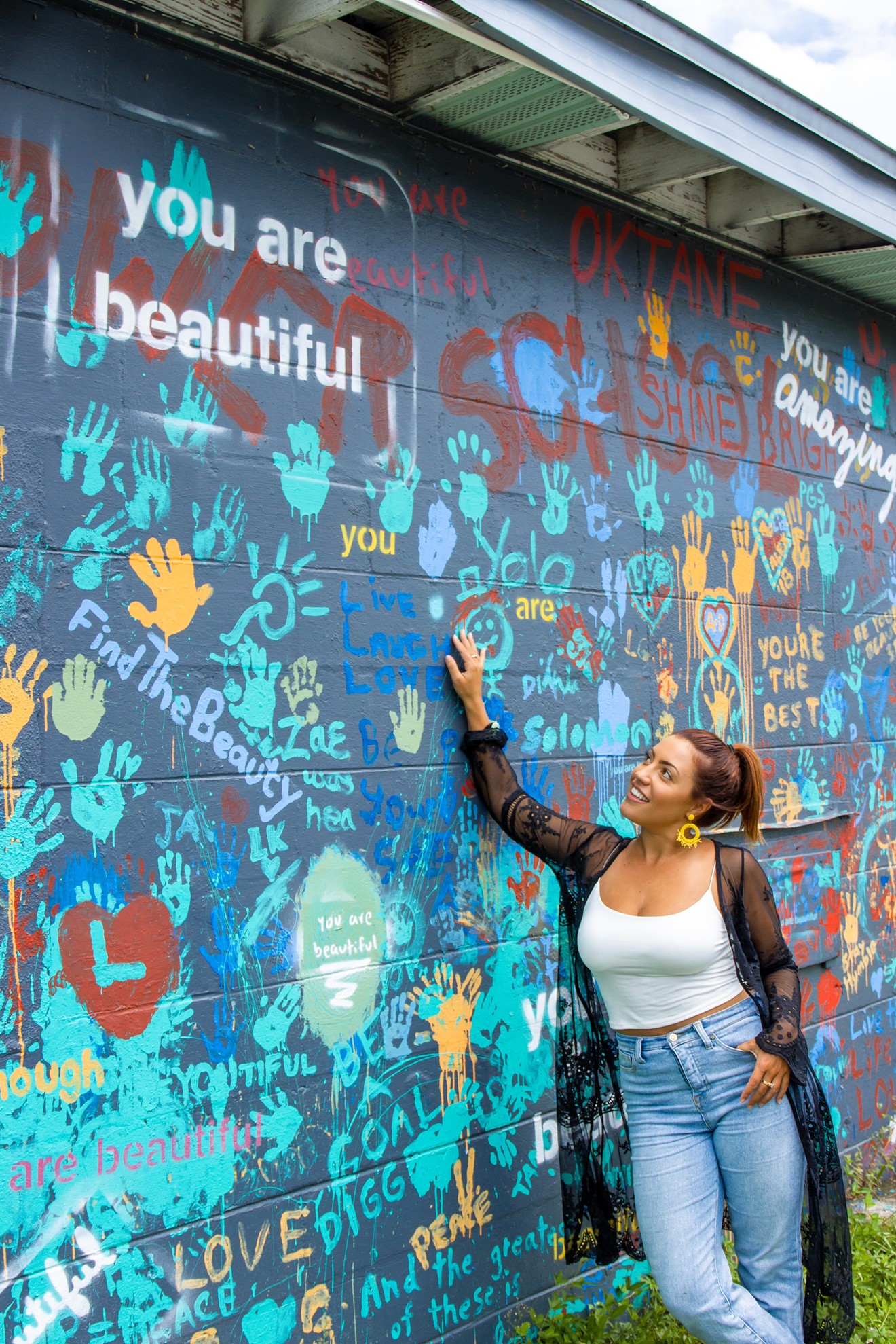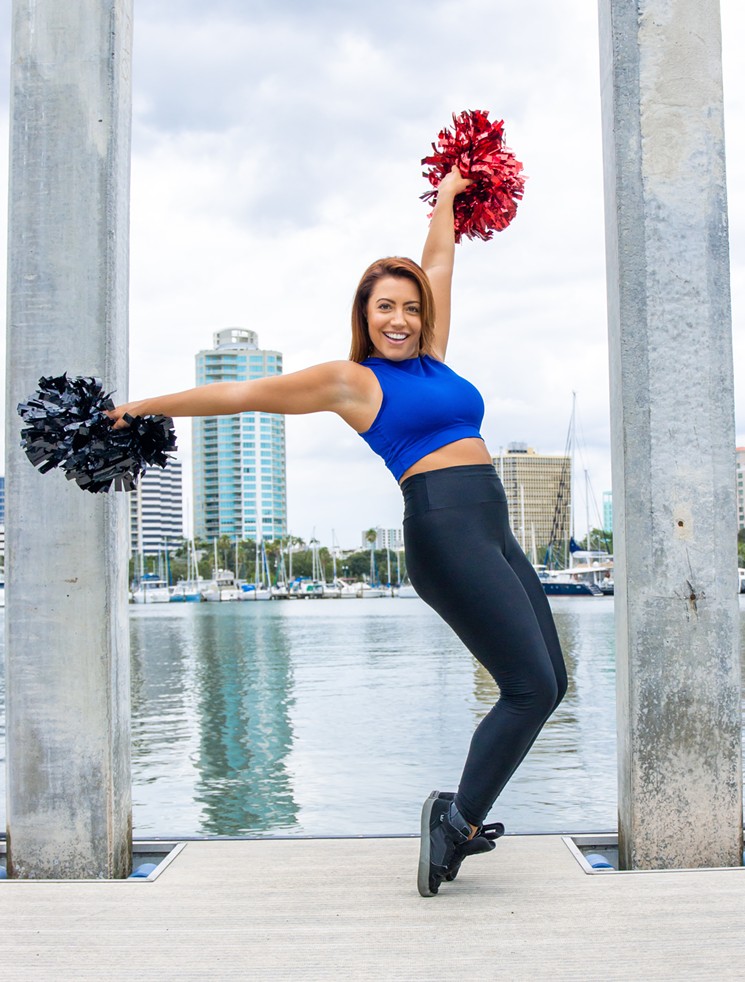Meagan Pravden can recite every word people have said to her about her body: "You kind of physically look stockier;" "she’s got more curve down the back of her thigh;" "today we had a little bit of thigh and butt running together, so we’re calling it a thutt"; "Meagan had a little bit of a thutt;" and "I don’t think our uniform fits your body."
That uniform was that of the Dallas Cowboys Cheerleaders, the one Pravden competed for in 2014. Her experience and the words said to her about her body played out on national television on Season 9 of CMT’s Dallas Cowboys Cheerleaders: Making The Team, a reality show documenting the rigorous process of becoming a Dallas Cowboys Cheerleader. Pravden, however, never made the team. The custom-made uniform didn't "fit" Pravden's body, as Kelli Finglass, DCC’s director, said on the show.
"We think you're a great performer and a great style dancer," Finglass tells Pravden on the show. "I don't think our uniform fits your body, and that was kind of evident in the uniform fittings yesterday. You can't change your body, and you don't need to lose weight. You're just a stockier build for this uniform."
“It wasn’t my weight,” Pravden tells the Observer from her workplace in Florida. “[Finglass] says it on the show. It was my legs. It was my build. It was my thutt. I said, ‘I would hang upside down if it would make my legs longer.’” The Dallas Cowboys did not respond to a request for comment on this article.
Even though it’s been six years since Pravden watched her training camp experience on TV, she wanted to revisit the pain it caused her. Pravden told her therapist she wanted to work through her body image issues before quarantine was over and before she began interacting with other people and dating. In an effort to speak up about body image, Pravden posted a compilation of clips about her body from DCC:MTT on her Instagram.
She made the post in order to heal and open a dialogue among other pro dancers and cheerleaders — and for anyone struggling with body image.
"Nothing I was doing felt good enough, and I never understood the WHY or the greater purpose of not making Cowboys," Pravden wrote on Instagram. "6 years later after a lot of reflection and work on myself I see exactly what that purpose was ...THIS! Empowering other women who are on their own body journey to heal and embrace their bodies just the way they are!! I am so excited to share my story and turn my pain into purpose."
Elizabeth Daniels, an associate professor at the University of Colorado at Colorado Springs, says she was "appalled" by the video Pravden posted on Instagram.
“They kept using the word stocky," Daniels says. "And I kept thinking, 'Do they know what the definition of stocky is?' It was just so ludicrous that her body is somehow too large for the aesthetic that they were going for.
“I think that really highlights that this is not about anything real and important," Daniels continues. "It’s about the arbitrary and incredibly narrow appearance standards that [are] apposed on women."
The Dallas Cowboys Cheerleaders’ look is modeled after the 1960s “exotic dancer” Bubbles Cash, according to the 2018 documentary Daughters of the Sexual Revolution: The Untold Story of the Dallas Cowboys Cheerleaders. When then-Cowboys President Tex Schramm saw Cash walk down the stadium’s aisle with her mini skirt and hands full of cotton candy, he had a vision to turn the cheerleaders — who were once high schoolers doing stunts on the sidelines — into something more. Schramm suggested the cheerleaders be models, according to a Dallas Cowboys’ video detailing the history of the DCC uniform. That idea has survived nearly 50 years. During an episode of DCC:MTT within the last few years, Finglass said the ideal body shape for a DCC is like an old pin-up girl, 36 inches at the bust, 24 at the waist, and 36 at the hips.
Pravden wasn’t the first to be body-shamed on the show. Since Season 1 in 2006, the directors have told the women all sorts of things about their bodies. Rachel is long and lean. I wish she was a bit curvier. Kathleen looks maybe a little too little. If they have a really square body type, it just doesn’t work in our uniform. Her short legs really bother me.
Pravden says body-shaming words aren’t unique to the Cowboys organization; it’s a problem throughout most professional cheerleading and dancing — something Pravden knows because she’s been dancing her entire life and joined her first professional team at age 18. That’s when she experienced her first feeling of thinking her body wasn’t good enough.
“Like, literally, (team directors) saying, ‘Well, your weight is here, and we’d like it to be more here,’” Pravden says while moving her hand down to symbolize her weight going down. “Before the first photoshoot being told, ‘Cover yourself in hemorrhoid cream, wrap yourself in Saran wrap because your body will look tighter tomorrow.’ And that was told to all the teammates.” (Pravden was not referring to the Cowboys.)
Dallas Cowboys Cheerleaders: Making The Team has shifted the dialogue about the women’s weight through its 14-season history. In earlier seasons, there was always an episode or two focused on working out with the team’s personal trainer, Jay Johnson. But in more recent seasons, the show has replaced workouts with segments featuring nutritionists teaching the women how to eat a healthy diet.
Still, a woman can get cut for gaining weight or not looking "ideal" in the famous uniform. The show’s most recent season featured a segment centered around healthy cooking. That same episode showed a cheerleader passing out at the team’s evening practice because she hadn’t eaten since noon that day.
Alexis Conason, a psychologist in private practice and founder of The Anti Diet Plan, says Pravden's story elicits outrage because Pravden meets "traditional beauty standards." But Conason notes that people should be outraged by all body shaming.
“It’s one thing to be outraged when something like this happens to a thin woman, but we also have to keep in mind that this is a woman with a lot of privilege who really does meet the traditional beauty ideals," Conason says, "and we also have to be outraged at the ideals that disproportionately harm people who don’t look like her.”
Conason says body shaming can have the potential to affect someone for the rest of their life and lead to eating disorders and mental illnesses. Pravden says she was "lucky" she never had an eating disorder, but she did struggle with body dysmorphia, which is a mental health disorder in a person constantly thinks about the "perceived defects or flaws" in their appearance, according to the Mayo Clinic.
“I don’t want those girls coming off teams, my friends, or girls coming off any team, to sit there and compare themselves to the girls they were when they cheered and do this to themselves for a decade,” she says.
Mhkeeba Pate, a former NFL cheerleader and host of Pro Cheerleading Podcast, says when women finish their pro dancing careers, they often struggle with coming to terms with their new image.
“When you’re a pro cheerleader, the stress on your body, the frequency of what you’re practicing, dancing, and you can’t really replicate that once you retire,” Pate says. “When you’re looking at how your body is changing, it’s really, really hard to embrace the reason why your body looks different, but you’re just not doing as much in terms of physical activity. You can work out like crazy, but it’s different.”
Being one of the Dallas Cowboys Cheerleaders — or any pro dancer — takes stamina. The DCC’s opening dance at football games lasts more than four minutes and ends with a high-power kickline. Once the game starts, the cheerleaders dance every time a piece of music comes on. Pravden says if a woman can dance her best and keep up the stamina, then all body types should be accepted.
“Your best physical shape can look different than someone else’s, and that is what I want to see change," Pravden says. "Perfect example was Kelli (Finglass) saying, ‘It’s not your dancing. Your dancing is good.’ And I felt that I could have contributed as a great teammate, as a great community role model and that unfortunately, my journey came to an end early specifically because of my proportions, which was just something I couldn’t really affect.”












